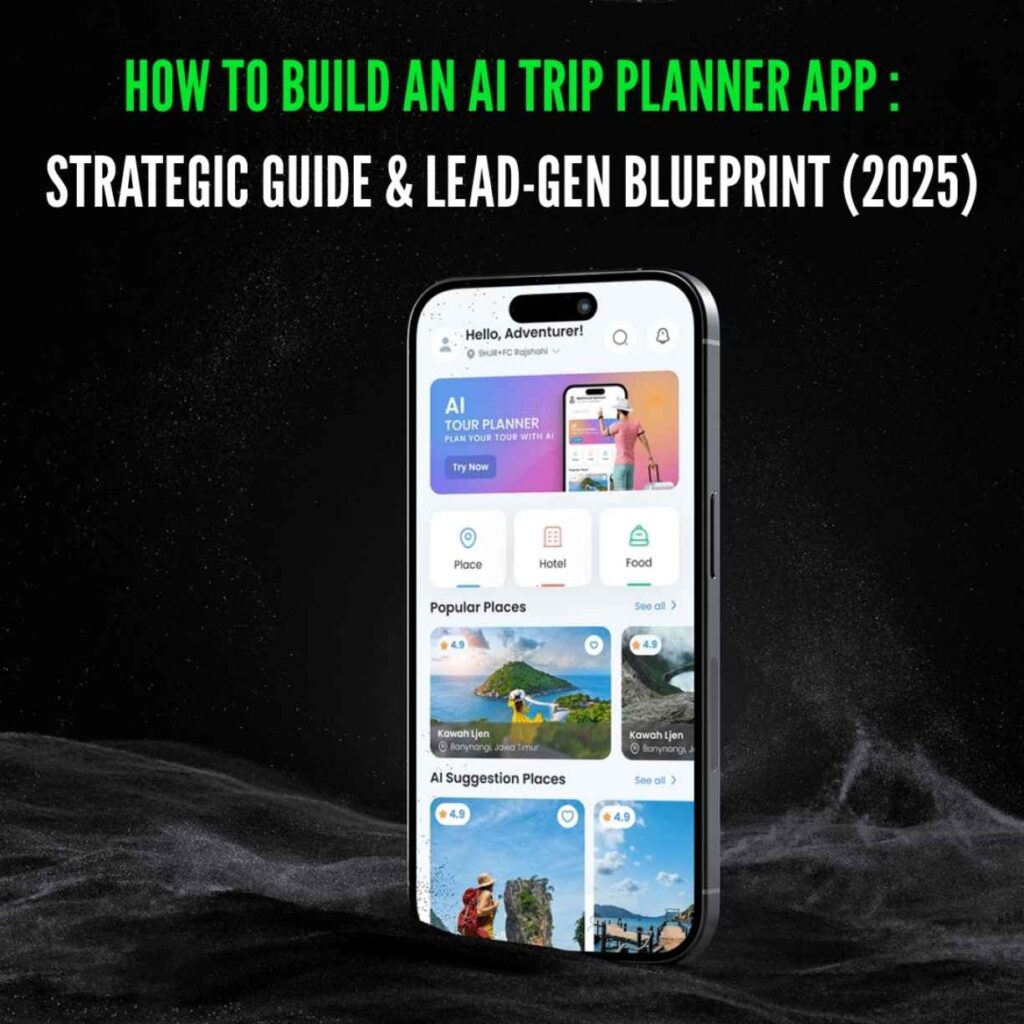|
Getting your Trinity Audio player ready...
|
By 2025, AI, personalisation, and automation will significantly transform the global travel industry. The intelligent trip planners would do away with the conventional static booking sites, providing hyper-personalised travel planning experiences with customisation and providing virtual travel concierges to assist travellers to create seamless plans.
Recent market forecasts indicated that the new digital travel planning market will exceed $600 billion by 2026. AI-powered platforms will account for over 30% of this growth. The traveller of today faces a deluge of fragmented information, overwhelming choices, and horrendously tangled coordination across flights, hotels, and local experiences; the result is friction and opportunity.
An AI trip planner resolves all of these problems and creates higher booking conversion rates, better customer retention, and improved ancillary revenue. From curating itineraries to smooth nudge delivery during the course of travel, AI will hold hands with users from inspiration through to post-trip sharing with minimal friction.
No travel tech startup, company, or OTA must waste time introducing an AI trip planner – it has become obligatory for every travel tech firm to establish such planners to remain relevant, capture market share, and build long-term customer loyalty in the extremely competitive travel ecosystem.
Strategic Differentiators & Value Propositions
The AI trip planner needs to stand out in the very crowded travel tech world and must present an obvious, persuasive, and differentiated value. Here are the four critical pillars:
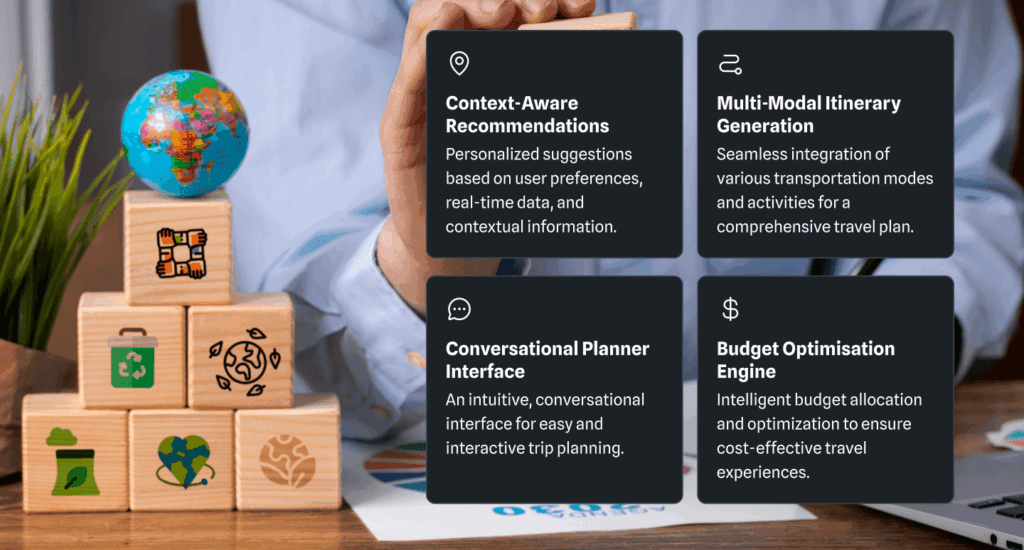
Context-Aware Recommendations:
The next generation of AI can indeed adapt in real time, unlike rule-based planners; it can customise suggestions based on individual user interests (adventure, well-being, gastronomy), travel seasons, real-time weather, local events, and even geopolitical alerts. Depending on whether the user is a solo backpacker or a family of five, recommendations vary and are highly relevant.
Multi-Modal Itinerary Generation:
A trip is much more than just flights and hotels. A robust AI planner connects transportation (trains, buses, rental cars), accommodation, restaurants, guided tours, attractions, and even visa requirements into a single seamless itinerary—thus saving much manual coordination from the users.
Conversational Planner Interface:
The next future of UX is conversational. Your planner needs to accommodate NLP-powered chat interfaces through which users can add, remove, or postpone anything in their trips while on the go: “Add a wine-tasting tour in Napa on Day 2″—just like that in seconds.
Budget Optimisation Engine:
One of the biggest game changers AI could offer is budget optimisation. Balancing time versus money and experience, AI can propose “best value” choices subject to user preferences or constraints.
These features enhance user satisfaction and increase the efficiency of the booking funnel, thereby differentiating your app as a real travel partner and not just another aggregator.
Core AI Modules & Data Pipelines
Breaking down the tasks of building a high-level AI trip planner, an architecturally sound intelligence layer and a more than efficient data infrastructure must be put in place. Structuring the two would, therefore, mean dexterously creating:
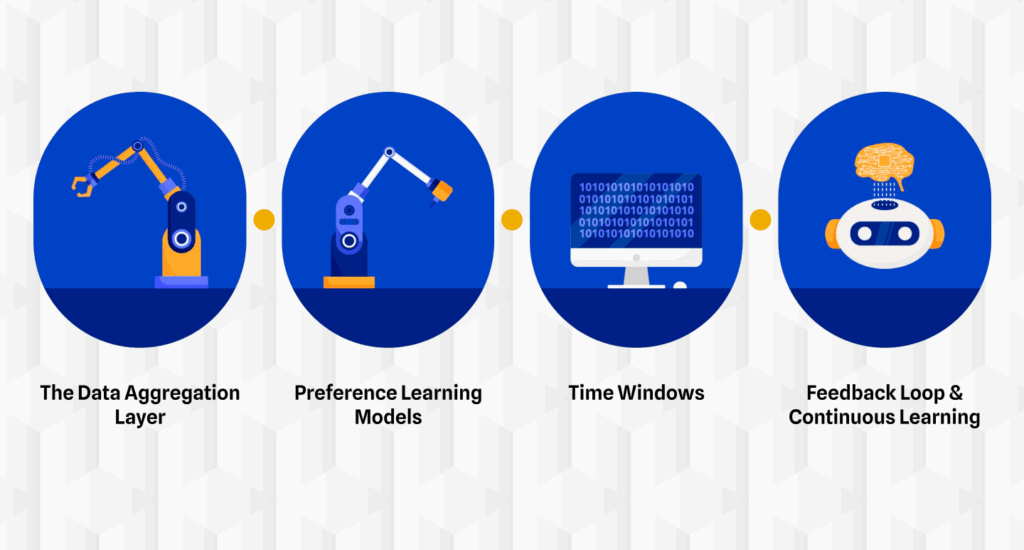
The Data Aggregation Layer
From the layers, structured and unstructured data from the following will be gathered:
- GDSs (Global Distribution Systems) such as Amadeus and Sabre
- OTAs, like Expedia, Booking.com, Airbnb
- Attraction APIs (e.g. Viator, GetYourGuide)
- Weather and Event Feeds to contextualize activities
- User-generated content for reviews and social validation
An ingestion pipeline for real-time schema and unified deployment must stay put for availability and pricing to be accurate.
Preference Learning Models
Preference learning models of collaborative filtering should aid users with shared behaviours, while new users receive content-based preference recommendations. Reinforcement learning should be used to tweak the data in real time based on user activities. The consideration of different AI signals could be:
- Trip history
- Engagement patterns (likes, scrolls, skips)
- Budget sensitivity
- Local/cultural interests
- Itinerary Optimization Engine & Other Subsystems
In this context, AI will utilise its specialised algorithms. The engine relies on constraint satisfaction algorithms and multiobjective optimisation to balance the following:
Time Windows
- Transport Connections
- Duration of Activities
- Users prefer to do the theme (relaxation vs. exploration)
- Real-Time Adjustment Layer
Your application should adapt within minutes to any disruptions to the plan, such as flight delays, sudden rain, or closed attractions. The primary impulse must come from software that immediately triggers the reorganisation of packets, puts out alerts, or offers the user an alternative.
Feedback Loop & Continuous Learning
The ML pipeline merges the feedback received after travel, ratings, cancellation, and usage logs in such a way that they would regressively play back into the model, reshaping recommendation models. Therefore, one hopes that future AI configurations retain their relevance and personalisation while only becoming stronger with age.
After working together, these modules form the AI nucleus of an intelligent travel companion.
Integration Ecosystem & Technical Architecture
The systems with which an artificial intelligence application interacts determine its effectiveness. The following discussion will elaborate on key integration layers and architectural choices for an AI trip planner:
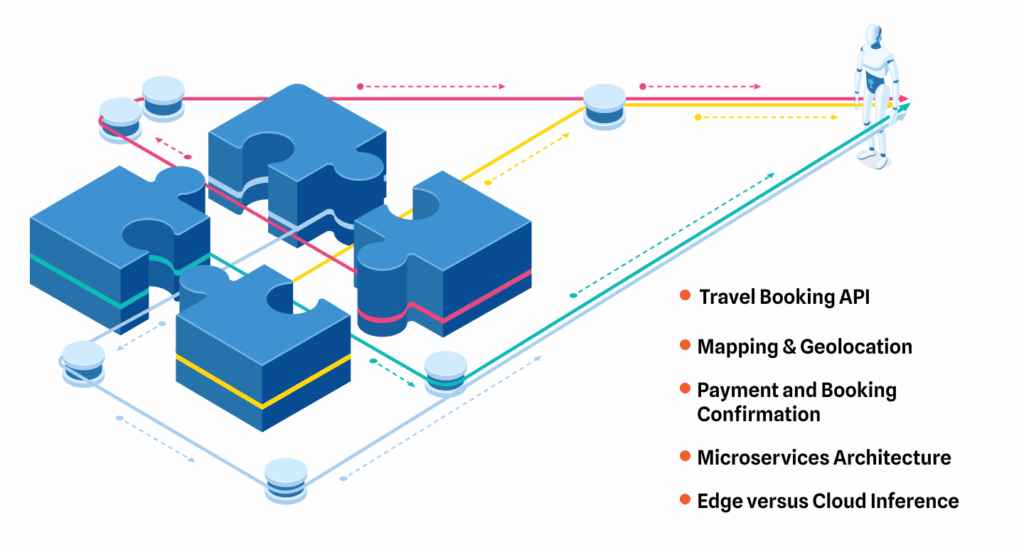
Travel Booking API
In the context of real-time inventory and reservation, integrations have to be done with:
- Amadeus, Sabre (flights)
- Expedia, Booking.com, Airbnb (lodging)
- Rail Europe, Rome2Rio (ground transport)
- GetYourGuide, Viator (activities)
Mapping & Geolocation
The features include routing, geofencing, and points of interest (POI) discovery using Google Maps or Mapbox. Custom layers can show clusters of interests specific to the user.
Payment and Booking Confirmation
Payments should be secure and seamless if made via:
- Stripe or PayPal
- Worldwide coverage
- Direct GDS connections for ticketing and confirmation retrieval
- Multiple currency and regional taxes supported
Microservices Architecture
Organise your platform as a containerised service for:
- AI engines (recommendation, optimization)
- Data ingestion
- User session management
- UI rendering
By using Kubernetes, scale deployments and build customisable agile architecture.
Edge versus Cloud Inference
Edge inference provides instant responsiveness for AI functions related to navigation changes and offline trip previews for mobile-first end-users, while heavy training and optimisation efforts are conducted in the cloud.
This architecture ensures performance, security, and global scalability – the core of functional travel apps.
UX/UI Blueprint for Seamless Planning
A fantastic AI can hardly be appreciated without a seamless user experience. Here is an outline of how to build a UI that is user-friendly yet highly retained:
Progressive Disclosure
Only simplify the planning process by prioritising the most relevant details, such as the date, destination, and number of travellers. Let users “zoom in” to details when they need them, not all at once.
Dual Pane Interface
A visual timeline view should be placed alongside a map view. For every action of building or modifying a plan, the user should be able to observe both the sequence of events and geographic flow in real time.
One-Click Modification
Drag and drop to change the days or the activities, while gestures such as swiping forward to skip and tapping to expand are essentially the essence of the system. Everything in the interface should feel effortless.
Conversational Onboarding
You like going to museums? So friendly will be the experience with Q&A bots or voice assistance technology taking care of the chatter for you. Hiking? Be ready to have a good orientation enhancing personalisation-low pressure.
Design matters, not only its aesthetics but more so how it drives behavioural change. A good UX is analogous to the completion ratio against trip, conversion, and lifetime worth.
Personalisation & Engagement Tactics
A smart AI trip planner must keep engaging users even after onboarding. Here is how:
Smart Notifications
Alerts should be sent proactively to:
- Flight price drops
- Upcoming check-ins
- Opening of events or changes in weather
These notifications should be felt as beneficial and constructive, and definitely not spam, depending on contextual significance.
Gamification Elements
Encourage usage through:
- Travel badges for visited countries
- Milestones on the user’s itinerary (“You’ve planned 3 perfect weekends!”)
- Leaderboard/shares to nurture social virality
- Local Insider Tips
Leverage AI to find lesser-known places: a quiet rooftop bar in Kyoto or a sunrise hike in the Dolomites, then match those with trend data and traveller profiles.
Multi-Channel Sync
Maintain continuity between:
- Mobile apps: iOS and Android
- Web dashboards
- Voice interfaces: Alexa and Google Assistant
Engagement is the bridge connecting planning and rebooking. Personalisation creates memories.
Compliance, Trust & Data Privacy
Trust is vital in the travel industry and in sharing personal and payment data. Therefore, your intelligent trip planner AI should comply with high standards in security and legality.
GDPR & CCPA Compliance
Create convenient consent management flows. Allow users to:
- Opt in/out of data tracking
- View/edit their stored information
- Request deletion (right to be forgotten)
- Ensure privacy policies are clear and easily accessible.
Secure Storage & Encryption
Encrypt all personal and payment data with AES-256 for data at rest and TLS 1.3 for data in transit, and utilise PCI-DSS compliant processors to secure transactions.
Explainable AI
Provide users with insights into the suggestions offered by the feature. Such suggestions may include:
- “This was suggested because you liked Paris and nature trips.”
- “Alternative: Less crowded but similar vibe.”
AI doesn’t have to be a black box. When the AI is transparent, users will trust it more, and the generation of support tickets will significantly decrease.
Pilot Program & Proof-of-Concept Roadmap
Before scaling up, test your AI trip planner with a limited and controlled pilot. This roadmap can be done in 6-8 weeks.
Step 1: Define Pilot Group
This will include early adopters, like:
- Frequent Travelers: overall
- Business Travelers Who Travel on a Predictable Basis
- Travel Influencers for Spread
- B2B Clients (e.g., travel agencies, corporate travel desks)
Step 2: Define Success Metrics
Measure:
- Trip Completion Ratios
- Booking Conversion Uplift
- Users Satisfaction (NPS)
- Points Fans Dropped During Planning Journey
Step 3: Stakeholder Engagement
Partner with a local airline, boutique hotel chain, or destination tourism application board. Those partnerships open up more perks through exclusive data sets and co-branding opportunities.
Step 4: Feedback Loop
The program includes built-in feedback mechanisms, ratings, and optional interviews conducted after users complete their travels.
Step 5: Scale Criteria
If the pilot meets thresholds (20% conversion uplift, NPS>70), expand the program to new geographies, segments, or channels.
Pilots reduce the risks associated with development, attract investors, and introduce essential features prior to the launch.
Cost Breakdown & Pricing Strategies
Understanding investment and monetisation avenues is paramount. Given this, a completely transparent budget and revenue framework are set below:
MVP Development (USD $100K-150K) will include:
- AI itinerary planner.
- Integration of flights, hotels, and activities.
- Responsive web/mobile UI.
- Some basic level of personalisation engine.
Full-Featured Platform (USD $200K-400K) will further add the below:
- Real-time optimisation.
- Conversational interface.
- Edge-cloud inference splits.
- Multi-language support.
- Dynamic pricing feeds.
Cost Variables
- Licenses for data sources
- The complexity of the AI models
- Cloud or hybrid infrastructure
- Global compliance (legal + localization)
Revenue Streams
- Affiliate Commissions: Earn % from bookings via GDS or OTAs
- Premium Subscriptions: Concierge features such as itinerary revisions or 24/7 access to an agent.
- Sponsored Listings: Restaurants or tours can bid for placement.
- Local Vendor Partnerships: Share revenue from bookings with on-ground service providers.
TCO Considerations
Plan for:
- Monthly API usage fees (GDS, maps, weather)
- Hosting costs (AWS/GCP/Azure)
- Support staff and SLA enforcement
A flexible pricing model ensures both B2C and B2B monetisation potential.
Risk Mitigation & SLA Guarantees
The trust of stakeholders will be instilled in a proactive risk management and performance assurance application.
Uptime SLAs
The system will ensure a 99.9% uptime guarantee for core booking and itinerary services of an infrastructure with multi-zonal deployment and auto-scaling.
Recommendation Accuracy
Aim for 95% relevance in suggested activities and accommodation, based on click-throughs, ratings, and completion rates.
Fallback Mechanisms
If the AI goes wrong with missed context or system error, allow the user to switch to live agents or chatbots in the app for human support.
Real-Time Monitoring
Constant monitoring of:
- API latencies and failure rates
- AI model drift
- Booking confirmation delays
Automated alerts for rollback or rerouting processes should sustain redundancy.
Reliability is your greatest asset in a very high-risk, real-time space like travel.
Why Esferasoft? Domain Expertise & Delivery Model
Since 2012, Esferasoft has been a company focused on AI-driven digital transformation in travel. Our journey is filled with successes, including enterprise-grade AI planners, concierge chatbots, and dynamic pricing engines.
Case Studies
- A personalised trip bot for a Middle East OTA yielded a 23% increase in the average order value.
- AI-Powered Tour Recommender for an EU city guide app resulted in a 30% increase in retention.
End-to-End Capability
Our team delivers holistic solutions. Data engineering, AI model designing, UX/UI designing, payment integration, etc.
Agile Delivery
We work in 2-week sprints, along with demo checkpoints, stakeholders’ reviews, and rapid iteration cycles.
Dedicated Travel Support
Our travel veterans man the support team, available 24/7, fluent in tech and hospitality alike.
With Esferasoft, you don’t just build an app; you launch a future-proof travel platform.
Ready to Redefine Travel? Launch Your AI Trip Planner Today!
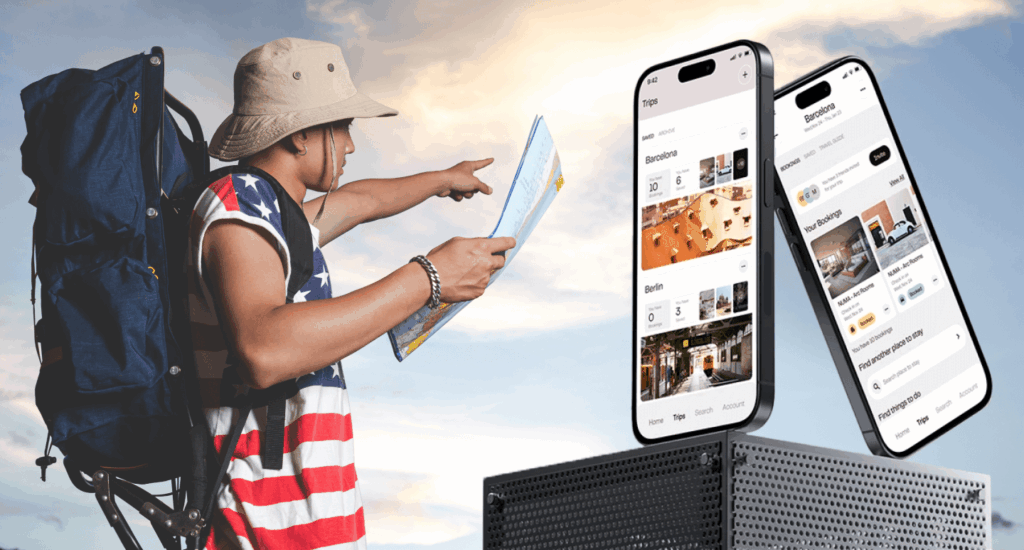
Are you ready to make that AI travel planner dream a reality?
Book a free AI Trip Planning Workshop customised specifically for your business objectives and user personas by our strategy team. We’ll assess technology readiness, define the MVP scope, and summarise the launch roadmap.
Only five slots are left for pilots in Q4 2025, so grab the early mover advantage fast.
Schedule a Discovery Call Now at +91 772-3000-038!
Let’s change the future of travel together.

